April 7th – Scots Book of Days
April 7 Tytlers History of Scotland from Encyclopaedia Britannica
1546 A.D. Decree of The Holy Scriptures prepared to issue on the 8th of April . Beginning in 1545, the Council of Trent, which continued eight years. was an ecumenical council of the Catholic Church Prompted by the Protestant Reformation, it has been described as the embodiment of the Counter-Reformation.
 Pope Paul III c(1534-1549) convened the Council of Trent 1545 to
Pope Paul III c(1534-1549) convened the Council of Trent 1545 to
Council of Trent met twenty-five sessions between 13 December 1545 and 4 December 1563. Pius IV sent the decrees to Mary, Queen of Scots, with a letter dated 13 June 1564, requesting her to publish them in Scotland, but she dared not do it in the face of John Knox and the Reformation.
- A.D. Sometime this year. Edward VI. King of England. –Henry II, King of France.
1549 Scotsman John Knox was licensed to work in the Church of England. Knox first commission was in Berwick-upon-Tweed.
1718 – Hugh Blair, Scottish preacher and man of letters born (d. 1800).
- Catholic and Presbyterian (Dissenters). Disenfranchising Act of 1728, exclusion from voting until 1793. England and Scotland eliminated voting among these religious fanatics, who would not take the Anglican Oath of Supremacy. If you are not an elector (you cannot vote) your testimony is not competent in a court (can’t be a witness), and your judgment is not reliable (can not sit on the grand jury or petit jury). Until 1728, Catholics voted in Irish House of Commons elections and held seats in the Irish House of Lords. For no particular reason, beyond a general pressure for Catholics to conform, Catholics were barred from voting in the election for the first parliament in the reign ofGeorge II (1745-1760).
 seal of Parliament of Ireland Wikipedia)
seal of Parliament of Ireland Wikipedia)
1747 (YYMA 30) minutes of Paisley presbytery regarding the progress of William Miller, son of Thomas Miller, minister at Kirkliston in West Lothian, and grandson of Andrew Millar, minister at Girvan in Ayrz. the Synod of Glasgow and Ayr minuted that ‘The Presbytery of Paisley intimates their Design of entering on tryals Mrs Will: Millar and Archd Smith students of Divinity concerning whom Letters were written in due time.’
1775 Boston Massachusetts. Gun control. The English have a secret plan to disarm the colonials, by confiscating the Colonials personal pistols and muskets. Across the ocean from Scotland, hundreds of thousands of Scots and their descendants are scattered 2,000 miles up and down the Atlantic coast of the colonies, many having been forced by the Highland Clearances. The English occupied Boston 3 years earlier and have identified different caches of colonial arms, particularly those at Lexington and Concord. Gun control will jump start the War of Independence and be the spark for the American Revolution. Meetings are held in churches and homes.
1805 – Francis Wilkinson Pickens, (April 7, 1805 – January 25, 1869) born. In 1758, Robert Miller (III) married Jane Pickens, Jane’s great-nephew, Andrew Pickens 2nd son, Francis ,was U.S. Senator, U.S. Minister to Russia 1858-60, chairman of the South Carolina Secession Convention of 1860 and Civil War governor of the State. Jane’s niece of the same name, Jane’s mother was Rebecca [94 YYMA] Calhoun, aunt of the U.S. Senator and Vice President, John C. Calhoun who was the architect of nullification. [Another descendant 7th great grand son of General Andrew Pickens is John Edwards, US Senator from North Carolina, and 2004 Democratic Vice Presidential candidate.]
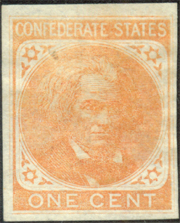 John C. Calhoun, Confederate States of America postal stamp issue of 1862
John C. Calhoun, Confederate States of America postal stamp issue of 1862
1829 Joseph Smith Jr wrote ‘Two days after the arrival of Mr. Cowdery (being the 7th of April) I commenced to translate the Book of Mormon, and he began to write for me.’ Joseph’s mother Lucy Smith (nee Mack) descended from Mack of Inverness Scotland.
1862 – American Civil War: Battle of Shiloh ends – the Union Army under General Ulysses S. Grant (clan Grant) defeats the Confederates near Shiloh, Tennessee. Grant was Scots descent.
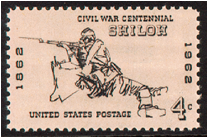 1962 April 7. “Riflemen at Battle of Shiloh, 1862” Civil War Centenary
1962 April 7. “Riflemen at Battle of Shiloh, 1862” Civil War Centenary
Forty-two thousand Union soldiers faced 40,000 Confederate troops April 6-7, 1862, at the Battle of Shiloh (Pittsburg Landing). Gen. Ulysses S. Grant led the victorious Union forces against Gen. Albert S. Johnston, who was killed in the battle. Gen. P.G.T. Beauregard took Confederate command and pushed the Union forces to the Tennessee River. Gen. Don Carlos Buell’s night arrival allowed the Union to take the offensive and gain victory. One of the most brutal battles of the war, Union casualties numbered 13,000, Confederate losses more than 10,000. usstampgallery.com
1853 – Prince Leopold, Duke of Albany, born, (d. 1884) son of Queen Victoria of England and Scotland, Ireland and India.
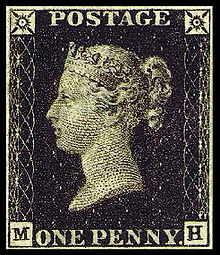 The British Penny Black is generally acknowledged as the world’s first postage stamp. 1840.
The British Penny Black is generally acknowledged as the world’s first postage stamp. 1840.
“Albany” was a broad territorial term representing the parts of Scotland north of the River Forth, roughly the former Kingdom of the Picts. The cities of New York and Albany, New York were thus both named after James (2nd of England, 7th of Scotland) as he was the Duke of York and Albany. The title of “Albany” alone was granted for the fifth time, this time in the Peerage of the United Kingdom, in 1881 to Prince Leopold, the fourth son of Queen Victoria. Prince Leopold’s son, Prince Charles Edward (who had succeeded as reigning Duke of Saxe-Coburg and Gotha in 1900), was deprived of the peerage in 1919 for bearing arms against the United Kingdom in World War I. Under the Titles Deprivation Act 1917, the legitimate lineal male heir of the 1st Duke of Albany (his senior agnatic descendant is currently the 2nd Duke’s great-grandson, Hubertus Prinz von Sachsen-Coburg und Gotha) may petition the British Crown for the restoration of the peerages.
1896 “The Star-Spangled Banner” was played by the Navy at the inaugural modern Olympic Games in Athens, 1896. Thomas Burke was the first athlete to represent the United States at the Olympics. He took first place in both the 100 meters and the 400 meters of the 1896 Summer Olympics in Athens, Greece.
1905 Speech, Siege at The Alamo Mission San Antonio, Texas Republic (February 23 – March 6, 1836) ends at the Battle of the Alamo on March 6 with list of Scots defenders. Restored in 1847 by Colonel James Harvey Ralston
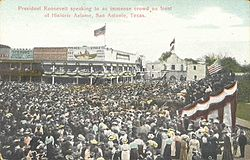 Theodore Roosevelt giving a speech at the Alamo, April 7, 1905.
Theodore Roosevelt giving a speech at the Alamo, April 7, 1905.
- Joseph F. Smith, President of the Church of Jesus Christ of Latter-day Saints, ordains his son, Joseph Fielding Smith, an Apostle of the Lord Jesus Christ. President Smith was ordained an Apostle 1 July 1866 by Brigham Young, President of the Church. Young was ordained an Apostle 14 February 1835 by the three witnesses Oliver Cowdery, Martin Harris, and David Whitmer, who were ordained to the Melchizedek Priesthood and set apart 14 February 1835, by Joseph Smith and Oliver Cowdery, who were ordained to the Melchizedek Priesthood May 1830, by the resurrected Peter, James and John, Apostles, and Presidency of the Quorum in the meridian of time, who were ordained Apostles about 30 A.D. by Jesus Christ, who was ordained circa 12 to 18 A.D. by his step father Joseph, and blessed by Simeon, Temple ordinance worker, AD 1 (Luke 2;25 & 34), and Wise Men (Mathew 2) and Moses and Elijah (Matt 17;3-4, Mark 9; 4-9, Luke 9;30, D&C 63;21, History of the Church 3;387).
1930 Time Cover Heber Jedediah Grant (clan Grant, Ivins, Huddleston)
In 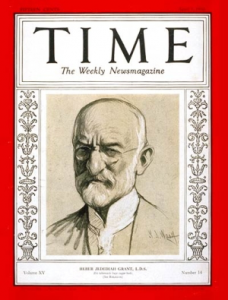 1882, aged 25, he was chosen one of the Twelve Apostles. During 1901-03 he lived in Japan as a Mormon missionary, then served two years as head of missionary activity in Europe.
1882, aged 25, he was chosen one of the Twelve Apostles. During 1901-03 he lived in Japan as a Mormon missionary, then served two years as head of missionary activity in Europe.
1995 Rob Roy, Filmed in Scotland. Robert Roy MacGregor (Liam Neeson) is a cattle drover and the leader of a clan in 18th century Scotland. Conceived, by its Scottish producer, Peter Broughan, developed with assistance from the Scottish Film Production Fund, with a Scottish director of international standing Michael Caton-Jones, and a screenplay by another Scot with a Hollywood pedigree, Alan Sharp, Rob Roy, financed by Hollywood, was home-grown, the first ever multi-million dollar film on a Scottish subject originated and actually shot in Scotland, (with non stop rain.)
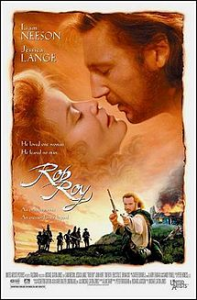 Poster. Glen Coe, Glen Nevis, and Glen Tarbert can be seen. In the opening scenes, Rob and his men pass by Loch Leven. Loch Morar stood in for Loch Lomond, on the banks of which the real Rob Roy lived.
Poster. Glen Coe, Glen Nevis, and Glen Tarbert can be seen. In the opening scenes, Rob and his men pass by Loch Leven. Loch Morar stood in for Loch Lomond, on the banks of which the real Rob Roy lived.
- ‘Twas then that we parted In yon shady glen,
- On the steep, steep side of Ben Lomond,
- Where in purple hue The Highland hills we view,
- And the moon coming out in the gloaming.
Scenes of the Duke of Argyll’s estate were shot at Castle Tioram, the Marquis of Montrose’s at Drummond Castle.
- Drummond of Cargill Stubhall Perth 8th c 2Hamilton2Stewart 2miller2Simmons 2Choate Zoë
Shots of “The Factor’s Inn” were filmed outside Megginch Castle. Crichton Castle was used in a landscape shot. In life, Rob Roy (b.1671) was older than both the Duke of Montrose (b.1682) and the Duke of Argyll (b.1678).
- Crichton of Brunstone 1100 2Gordon2Kennedy 2Stewart2Miller 2Simmons2Choate
2006 On a Clear Day filmed at the shipyards on the River Clyde in present day Glasgow, Scotland.
2013 0K Scotland Run in the Park hosted by the Scottish Government Private Reception for all models, designers, sponsors and Hosting Committee members of the From Scotland With Love fashion show.
Utah Standard News depends on the support of readers like you.
Good Journalism requires time, expertise, passion and money. We know you appreciate the coverage here. Please help us to continue as an alternative news website by becoming a subscriber or making a donation. To learn more about our subscription options or make a donation, click here.
To Advertise on UtahStandardNews.com, please contact us at: ed@utahstandardnews.com.


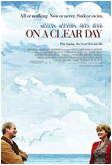
Comments - No Responses to “April 7th – Scots Book of Days”
Sure is empty down here...